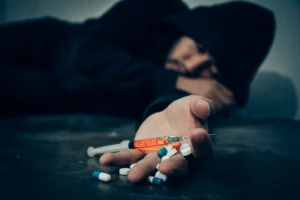Substance abuse among adolescents is a growing concern that transcends geographic, economic, and social boundaries. The teenage years are marked by exploration and vulnerability, making young individuals particularly susceptible to the allure of drugs and alcohol. This blog aims to shed light on the causes, effects, and prevention strategies of substance abuse in adolescence.
Contents
What Are the Stages of Drug Abuse In Adolescence?
 The stages of drug abuse in adolescence can be broadly categorized into several phases, each marked by increasing involvement with substances. Understanding these stages helps in early detection and effective intervention. Here’s an overview:
The stages of drug abuse in adolescence can be broadly categorized into several phases, each marked by increasing involvement with substances. Understanding these stages helps in early detection and effective intervention. Here’s an overview:
- Experimentation
This initial stage is often driven by curiosity or peer pressure. Adolescents may try drugs or alcohol in social settings without a regular pattern. The use at this stage is typically infrequent and voluntary.
- Regular Use
As the individual continues using the substance, the frequency of use increases. This stage may also see the beginning of emotional or psychological reliance on the drug to cope with problems, relieve stress, or feel good. Substance use may still be social, but the adolescent may begin using alone as well.
- Risky Use/Abuse
During this stage, the frequency and quantity of substance use increase significantly, leading to risky behaviors. This may include driving under the influence, using substances in dangerous situations, or facing legal issues related to substance use. School performance, relationships, and behavioral norms are often negatively affected.
- Dependence
Dependence is characterized by the compulsive use of the substance despite harmful consequences. Adolescents may experience withdrawal symptoms when they stop using the drug and may need to use more of the drug to achieve the same effects (tolerance). Substance use becomes a central focus of their life.
- Addiction
Addiction involves all the characteristics of dependence, coupled with a physical need. Changes in brain chemistry support compulsive behaviors and make cessation extremely challenging. At this stage, professional treatment is often necessary to recover.
Recognizing these stages early is crucial for effective intervention and to prevent the progression to more severe levels of substance abuse and dependency.
Signs of Substance Abuse in Adolescence
Adolescents may not always show clear signs of drug or alcohol use, as they often try to hide their behaviors from adults. However, several indicators can suggest a problem. Here are some common signs of substance abuse in adolescence:
1. Physical Changes
- Bloodshot eyes or pupils that are larger or smaller than usual.
- Sudden weight loss or weight gain.
- Unusual smells on breath, body, or clothing.
- Impaired coordination or slurred speech.
- Frequent nosebleeds (especially if related to snorted drugs).
- Seizures without a history of epilepsy.
2. Behavioral Changes
- Increased secrecy about activities or possessions.
- Sudden change in friends, favorite hangouts, and hobbies.
- Frequent trouble at school (fights, suspensions, poor grades).
- Missing money or valuables from the home, or frequent requests for money without a reasonable explanation.
- Use of incense, room deodorant, or perfume to hide smoke or chemical odors.
- Possession of drug paraphernalia such as pipes, rolling papers, and lighters.
3. Psychological Changes
- Unexplained, frequent mood swings and increased irritability, anger, or paranoia.
- Lack of motivation; appears lethargic or “spaced out.”
- Appears fearful, anxious, or paranoid, without reason.
- Sudden periods of hyperactivity or overtalking.
4. Health Issues
- Frequent sickness (unexplained headaches, chest pain, nausea, or vomiting).
- Changes in sleep patterns (insomnia or oversleeping).
- Neglected appearance (not caring about grooming or cleanliness).
5. Social Issues
- Withdrawal from family and usual friends.
- Legal problems related to substance use.
- Complaints from teachers or co-workers about changes in behavior or performance.
It’s important to approach these signs with concern rather than accusatory, as adolescents dealing with substance abuse issues need support and understanding. If multiple signs are observed, it might be necessary to seek professional help.
Risk Factors For Substance Abuse In Adolescence
 Substance abuse in adolescence carries significant risks that can impact nearly every aspect of a young person’s life. The adolescent brain is still developing, making it particularly susceptible to the harmful effects of drugs and alcohol.
Substance abuse in adolescence carries significant risks that can impact nearly every aspect of a young person’s life. The adolescent brain is still developing, making it particularly susceptible to the harmful effects of drugs and alcohol.
Risks factors
Here are some of the key risks associated with substance abuse during these formative years:
Brain Development Issues
Substance use can alter the development of the adolescent brain, particularly areas involved in decision-making, impulse control, memory, learning, and behavior regulation. This can lead to cognitive impairments and emotional difficulties.
Mental Health Disorders
Adolescents who abuse substances are at a higher risk of developing mental health disorders such as depression, anxiety, and psychosis. Substance use can exacerbate existing mental health issues or lead to the development of new conditions.
Academic Problems
Drug and alcohol use can negatively affect an adolescent’s ability to concentrate, study, and maintain good grades. This may result in poor school performance, higher truancy rates, and an increased likelihood of dropping out.
Social Problems
Substance abuse can lead to social withdrawal, deteriorated relationships with family and friends, and involvement with peers who may encourage further drug use. This can isolate the adolescent from positive influences and support systems.
Physical Health Issues
Drugs and alcohol can have immediate and long-term effects on the physical health of an adolescent. These include respiratory issues, cardiovascular problems, liver damage, and neurological effects. Some substances can also influence hormone levels, potentially leading to reproductive health issues.
Increased Risk of Accidents
Substance abuse impairs judgment and coordination, increasing the risk of accidents such as car crashes, falls, and other injuries. Adolescents under the influence are more likely to engage in risky behaviors.
Substance Dependency and Addiction
Early exposure to drugs and alcohol increases the risk of developing substance dependency and addiction later in life. This can set a pattern of behavior that may be difficult to break.
Understanding these risks is crucial for parents, educators, and health professionals to intervene effectively and help prevent the long-term consequences of substance abuse in adolescence.
What Are Medical Approaches To Consider?
When addressing substance abuse in adolescents, a comprehensive medical approach is essential, integrating both pharmacological and therapeutic strategies. Here are some of the primary medical approaches to consider:
Detoxification
The first step in treating substance dependence involves detoxification, which is the process of safely withdrawing from the substance. This is often done in a controlled, supervised setting to manage withdrawal symptoms effectively.
Pharmacotherapy
Medication-Assisted Treatment (MAT): This includes medications that can help manage withdrawal symptoms, reduce cravings, and treat co-occurring disorders. For example:
- Opioids: Medications such as buprenorphine, methadone, and naltrexone can be used to treat opioid addiction.
- Alcohol: Disulfiram, naltrexone, and acamprosate are commonly used to manage alcohol dependence.
- Nicotine: Nicotine replacement therapies (patches, gums, lozenges), bupropion, and varenicline are used for tobacco addiction.
- Medications can also be prescribed to treat underlying or resulting mental health issues like anxiety or depression.
Behavioral Therapies
Behavioral treatments are critical in helping adolescents modify their attitudes and behaviors related to drug use, and increase healthy life skills.
- Cognitive Behavioral Therapy (CBT): Helps patients recognize, avoid, and cope with situations in which they are most likely to use substances.
- Motivational Interviewing (MI): Aims to make individuals ready to change their behavior and enter treatment.
- Family-Based Therapies: Family therapy addresses family dynamics that contribute to drug use and other problematic behaviors. This may include therapies like Multisystemic Therapy (MST) and Family Behavior Therapy (FBT).
Continued Care and Relapse Prevention
Aftercare is crucial in maintaining sobriety. This can include outpatient support programs, peer support groups like 12-step programs, and ongoing counseling. Relapse prevention strategies are integrated throughout the treatment process to help individuals recognize and manage relapse risks.
Support for Co-Occurring Disorders
Often, substance abuse disorders co-occur with other psychiatric disorders. An integrated treatment approach that addresses both substance abuse and mental health conditions simultaneously is crucial for effective treatment.
Each treatment plan is individualized, considering the adolescent’s unique circumstances, the substances involved, and the presence of any co-occurring disorders.
How Can I Prevent Substance Abuse In Adolescence?
 Preventing substance abuse in adolescents involves a combination of family support, education, and healthy lifestyle reinforcements. Here are some concise strategies that can be effective:
Preventing substance abuse in adolescents involves a combination of family support, education, and healthy lifestyle reinforcements. Here are some concise strategies that can be effective:
- Open Communication: Foster an environment where open and honest discussions about the risks and consequences of drug use are encouraged.
- Education: Educate adolescents about the dangers of drug and alcohol use from an early age.
- Strong Relationships: Build strong, supportive relationships with adolescents; being actively involved in their lives can serve as a protective factor against substance use.
- Positive Role Models: Be a positive role model by exhibiting healthy behaviors and lifestyle choices.
- Monitor and Supervise: Supervise adolescents’ activities and know their friends and social circles to guard against negative influences.
- Set Clear Rules and Consequences: Establish clear family rules about substance use and consistent consequences for breaking these rules.
- Encourage Healthy Activities: Encourage participation in sports, hobbies, and other engaging activities that reduce boredom and stress, and build self-esteem.
- Stress Management: Teach adolescents healthy ways to cope with stress, such as through exercise, reading, or creative arts.
- Access to Resources: Provide access to resources and support for mental health issues, which can be underlying causes of substance use.
By implementing these strategies, you can help create a supportive and protective environment that discourages substance abuse during the vulnerable adolescent years.
Conclusion
In conclusion, addressing substance abuse in adolescence is crucial for fostering healthy development and ensuring a brighter future for our young individuals. By understanding the stages and signs of substance abuse, and implementing effective preventive and treatment strategies, we can help guide our youth towards making safer choices.
With informed awareness and proactive intervention, we can significantly reduce the impact of substance abuse on adolescents and help them thrive in their journey to adulthood.
